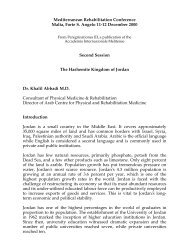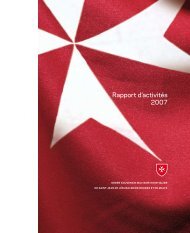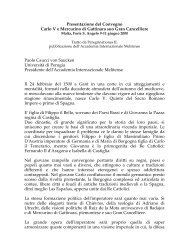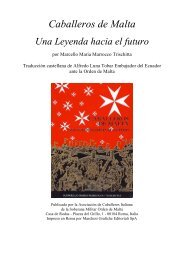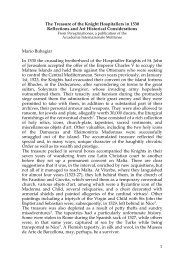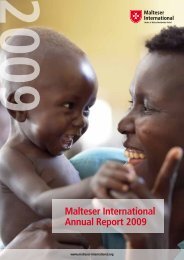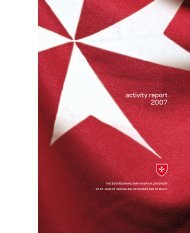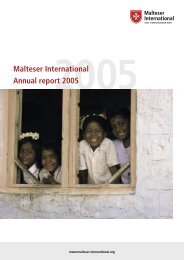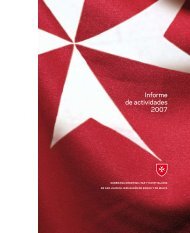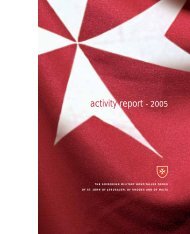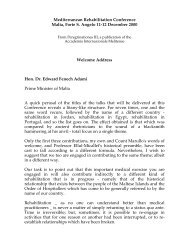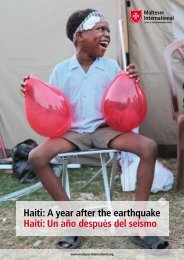Malteser International Annual Report 2007 - Ordine di Malta
Malteser International Annual Report 2007 - Ordine di Malta
Malteser International Annual Report 2007 - Ordine di Malta
You also want an ePaper? Increase the reach of your titles
YUMPU automatically turns print PDFs into web optimized ePapers that Google loves.
On the spot: South Sudan<br />
‘I got ill because I ate with a murderer’<br />
Fighting leprosy means fighting legends<br />
“It is closely connected to poverty.” –<br />
“If you kill my brother, and then you eat<br />
together with me, I will develop leprosy.<br />
Because I ate with my brother’s murderer.”<br />
– “It is given by birth. In my clan,<br />
there was never leprosy, so my relatives<br />
and I will never get it.” – “Somebody can<br />
bewitch you or put a bad curse on you so<br />
that you will get it.”<br />
This is what people ‘know’ about leprosy<br />
in Rumbek, South Sudan. This is also<br />
all that Majok had heard about leprosy<br />
when he developed blisters on his hands<br />
in January <strong>2007</strong>. Neither <strong>di</strong>d he know<br />
what leprosy looked like nor <strong>di</strong>d he understand<br />
that leprosy can hit everybody.<br />
That is why he <strong>di</strong>d not go to the hospital<br />
when the first symptoms occurred but just<br />
waited, hoping that the blisters would <strong>di</strong>sappear<br />
by themselves.<br />
With his three wives and ten children,<br />
Majok lives in the village of Ascholthen,<br />
close to Rumbek. Majok’s uncle Maker<br />
also lives in the very same village. Maker<br />
had also suffered from leprosy. When<br />
he saw Majok in June, with the blisters<br />
spread from the hands to the elbows and<br />
the knees and the feet, he said: “Listen! I<br />
had this illness as well, and I know where<br />
you can heal it!” And he took Majok to<br />
the State Hospital of Rumbek where <strong>Malteser</strong><br />
<strong>International</strong> runs a leprosy control<br />
programme and where he himself had<br />
been cured.<br />
Majok is lucky he came to the hospital<br />
early enough so that he will not lose any<br />
fingers, toes, limps or other parts of his<br />
body. He just needs to learn how to treat<br />
Anke Barth<br />
Majok tells his story.<br />
the ulcers on his own and as soon as he<br />
can do so he will then be allowed to leave<br />
the hospital and go back to his family.<br />
When Majok returns home a nurse of the<br />
<strong>Malteser</strong> <strong>International</strong> leprosy control<br />
programme will visit him regularly to<br />
check whether he is following the advice<br />
and if the blisters are <strong>di</strong>sappearing.<br />
Majok is not afraid of returning to his<br />
village after his recovery even though<br />
people who are affected by leprosy are<br />
still and very frequently stigmatised and<br />
excluded from society. “But when I told<br />
my people that I have leprosy they just<br />
refused (except for my uncle) to believe<br />
me and even today they will not believe<br />
it was leprosy! In this way, they have no<br />
problem with staying friends with me.”<br />
Majok is truly annoyed by this ignorance.<br />
“When I return to my village, I<br />
will show them my healing arms and<br />
legs and I will tell them that this was<br />
done by the drugs healing the leprosy.<br />
And I will ask them: How can it not be<br />
leprosy then?”<br />
Anke Barth<br />
Anke Barth<br />
Treating Majok’s wounds<br />
Africa<br />
17



